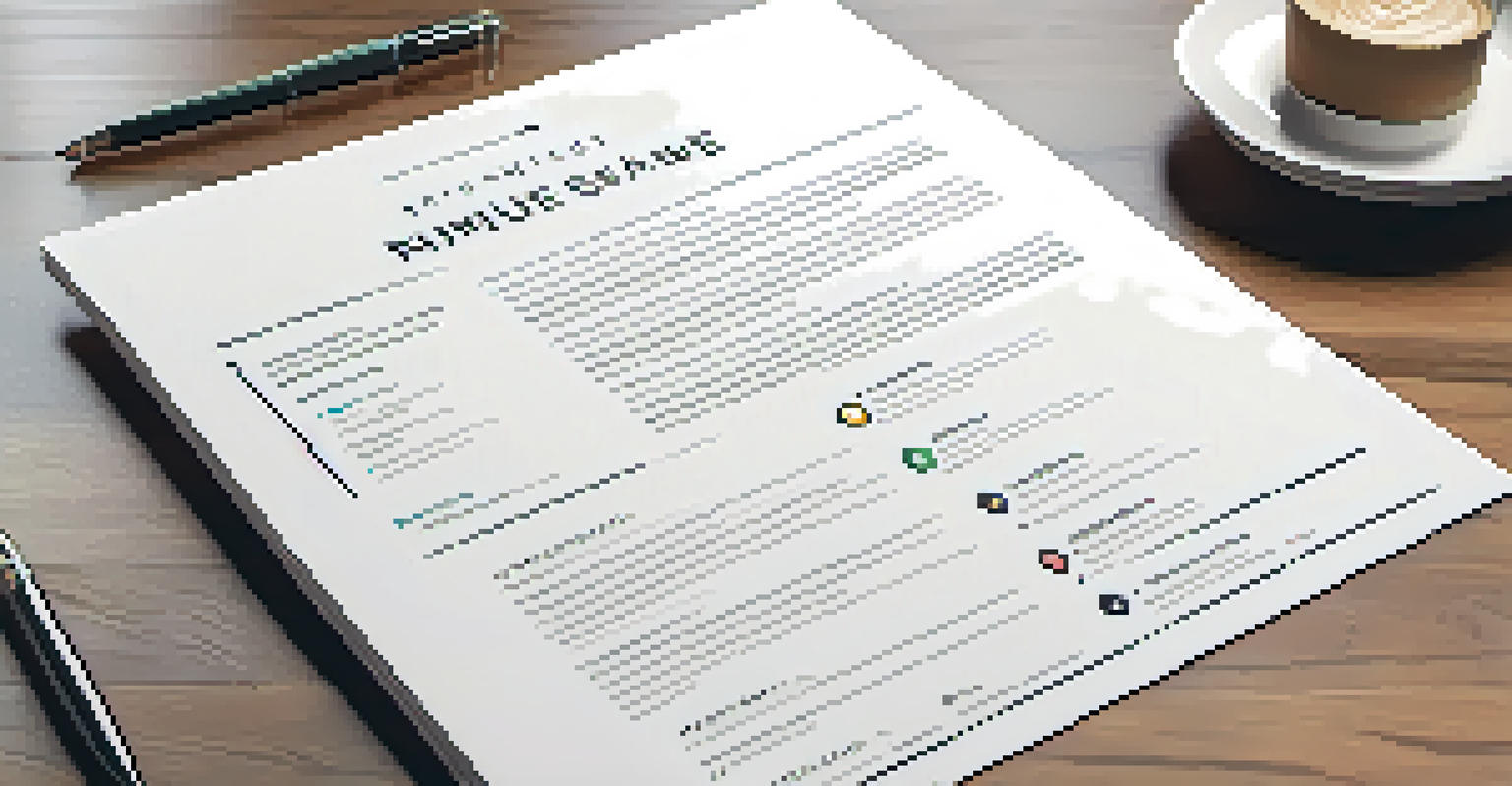The Role of Formatting in Resume Optimization

Understanding Resume Formatting Basics
When it comes to creating a standout resume, formatting serves as the foundation. It's not just about making your document look pretty; effective formatting ensures that your information is accessible and easy to read. Think of your resume as a map: the clearer the layout, the easier it is for employers to navigate your skills and experiences.
Formatting is not just about making things look pretty; it's about making them easier to read and understand.
The first step in formatting is choosing the right structure. Common styles include chronological, functional, and hybrid formats, each serving different purposes based on your career stage and job application. A well-structured resume can highlight your strengths and make a memorable impression on hiring managers.
Finally, consistency is key in formatting. Use uniform fonts, bullet points, and spacing to create a cohesive look throughout your resume. This attention to detail not only enhances readability but also conveys professionalism, showing potential employers that you take your job application seriously.
Choosing the Right Font and Size
Selecting an appropriate font is crucial in ensuring your resume is both readable and visually appealing. A clean, sans-serif font like Arial or Calibri often works best because it looks modern and is easy to read, even on screens. Remember, your goal is to make a great impression without distracting from your accomplishments.

Font size plays a significant role as well. Generally, 10 to 12 points is ideal for the body text, while headings can be slightly larger to grab attention. However, avoid going too small, as it can make your resume difficult to read, especially for those reviewing multiple applications.
Formatting Enhances Resume Readability
A well-structured resume with consistent formatting makes information accessible and easy for employers to navigate.
Lastly, ensure you maintain consistent font choices throughout your resume. Mixing fonts can create a jarring effect and make your document appear unprofessional. Stick to one or two complementary fonts to maintain clarity and cohesion.
Utilizing White Space Effectively
White space, or the empty space around your text and elements, is an often-overlooked aspect of resume formatting. It serves as a breathing room for your content, allowing the reader's eyes to rest and making the document less overwhelming. Think of white space like the space between frames in a movie; it helps to enhance the overall experience.
Your resume is a reflection of your professional self; make sure it shines.
Strategically using white space can also guide the reader's eyes to the most important information. For instance, leaving extra space around headings or between sections can help highlight your accomplishments and skills. This subtle technique can significantly improve your resume's scannability.
Moreover, a well-spaced resume appears more polished and professional. By ensuring that your content isn't cramped or cluttered, you'll make a strong impression on hiring managers, who will appreciate the effort you put into creating a clean and organized document.
Incorporating Bullet Points for Clarity
Bullet points are your best friend when it comes to resume formatting. They allow you to present information in a concise manner, making it easier for hiring managers to quickly scan your qualifications. Instead of lengthy paragraphs, bullet points help spotlight your achievements and skills effectively.
When using bullet points, focus on starting each one with strong action verbs that convey your contributions. For example, instead of saying 'responsible for managing a team,' you might say 'led a team of five to successfully complete projects ahead of deadlines.' This not only adds clarity but also emphasizes your impact.
Use Bullet Points for Clarity
Bullet points allow for concise presentation of achievements, making it easier for hiring managers to quickly scan qualifications.
Additionally, keep your bullet points brief—aim for one to two lines at most. This keeps your resume digestible and encourages hiring managers to read through your entire document without feeling overwhelmed by dense text.
Crafting Effective Headings and Subheadings
Headings and subheadings act like signposts on your resume, guiding hiring managers through your career journey. They help break down the content into digestible sections, making it easier for readers to find specific information, such as your work experience or education. Think of them as chapters in a book; clear titles make it easy to navigate.
When crafting your headings, make them bold and slightly larger than the body text to create a visual hierarchy. This differentiation draws attention to each section and helps organize your resume logically. Consistent formatting for headings also reinforces a professional appearance.
Moreover, using descriptive headings can enhance your resume's effectiveness. Instead of simply labeling a section 'Experience,' consider a more specific title like 'Relevant Work Experience' to provide context. This small change can make a big difference in how your qualifications are perceived.
Highlighting Key Information with Emphasis
Emphasizing key information in your resume can make a significant impact on how it's perceived. Techniques like bolding or italicizing important skills or achievements draw the reader's attention to your most impressive qualifications. Just like a spotlight on a stage, these techniques help ensure that your strengths shine through.
However, moderation is essential. Overusing emphasis can make your resume look cluttered and distract from the content. Use these techniques sparingly and strategically, focusing on the most vital elements you want to highlight, such as awards, certifications, or critical skills.
Tailor Resumes to Industry Standards
Adapting your resume formatting to fit industry-specific expectations can significantly improve your chances of making a positive impression.
Additionally, consider using color thoughtfully to differentiate sections or highlight key points. A subtle addition of color can enhance visual appeal, but stick to professional color palettes to maintain a polished look. This balance can help your resume stand out while remaining appropriate for the job market.
Adapting Formatting for Different Industries
Different industries have varying expectations when it comes to resume formatting, so it's essential to adjust your approach accordingly. For instance, creative fields like graphic design may allow for more innovative layouts, whereas traditional sectors like finance often favor straightforward and conservative styles. Understanding these nuances can be the key to making a positive impression.
Researching industry-specific resume trends can inform your formatting choices. Look at examples from professionals in your desired field to identify common practices, such as font choices or section organization. Tailoring your resume to fit the industry can demonstrate your understanding of its culture and expectations.

Ultimately, aligning your resume formatting with industry standards not only helps you fit in but also allows your unique qualifications to shine. By presenting your information in a way that's familiar to hiring managers, you increase your chances of making it past the initial screenings.
Finalizing Your Resume for Submission
Before hitting the 'send' button, it's crucial to finalize your resume formatting. This means ensuring that all elements are correctly aligned, fonts are consistent, and there are no spelling or grammatical errors. A polished resume reflects your attention to detail, which is a vital trait in any job seeker.
Consider converting your resume to PDF format for submission. This helps preserve your formatting across different devices and ensures that it looks the same to every hiring manager. It's a simple step that can prevent any unexpected changes in layout when your resume is opened.
Finally, don't forget to tailor your resume for each job application. Adjusting specific sections based on the job description not only demonstrates your genuine interest but also helps you highlight the most relevant skills and experiences. This final touch can significantly enhance your resume's effectiveness.